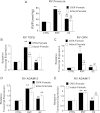Reverse right ventricular structural and extracellular matrix remodeling by estrogen in severe pulmonary hypertension
- PMID: 22628376
- PMCID: PMC3404831
- DOI: 10.1152/japplphysiol.01349.2011
Reverse right ventricular structural and extracellular matrix remodeling by estrogen in severe pulmonary hypertension
Abstract
Chronic pulmonary hypertension (PH) leads to right-ventricular failure (RVF) characterized by RV remodeling. Ventricular remodeling is emerging as an important process during heart failure and recovery. Remodeling in RVF induced by PH is not fully understood. Recently we discovered that estrogen (E2) therapy can rescue severe preexisting PH. Here, we focused on whether E2 (42.5 μg·kg(-1)·day(-1), 10 days) can reverse adverse RV structural and extracellular matrix (ECM) remodeling induced by PH using monocrotaline (MCT, 60 mg/kg). RV fibrosis was evident in RVF males. Intact females developed less severe RV remodeling compared with males and ovariectomized (OVX) females. Novel ECM-degrading disintegrin-metalloproteinases ADAM15 and ADAM17 transcripts were elevated ∼2-fold in all RVF animals. E2 therapy reversed RV remodeling in all groups. In vitro, E2 directly inhibited ANG II-induced expression of fibrosis markers as well as the metalloproteinases in cultured cardiac fibroblasts. Estrogen receptor-β agonist diarylpropionitrile (DPN) but not estrogen receptor-α agonist 4,4',4″-(4-propyl-[1H]-pyrazole-1,3,5-triyl)trisphenol (PPT) was as effective as E2 in inhibiting expression of these genes. Expression of ECM-interacting cardiac fetal-gene osteopontin (OPN) also increased ∼9-fold in RVF males. Intact females were partially protected from OPN upregulation (∼2-fold) but OVX females were not. E2 reversed OPN upregulation in all groups. Upregulation of OPN was also reversed in vitro by E2. Plasma OPN was elevated in RVF (∼1.5-fold) and decreased to control levels in the E2 group. RVF resulted in elevated Akt phosphorylation, but not ERK, in the RV, and E2 therapy restored Akt phosphorylation. In conclusion, E2 therapy reverses adverse RV remodeling associated with PH by reversing fibrosis and upregulation of novel ECM enzymes ADAM15, ADAM17, and OPN. These effects are likely mediated through estrogen receptor-β.
Figures








Similar articles
-
Estradiol improves right ventricular function in rats with severe angioproliferative pulmonary hypertension: effects of endogenous and exogenous sex hormones.Am J Physiol Lung Cell Mol Physiol. 2015 May 1;308(9):L873-90. doi: 10.1152/ajplung.00006.2015. Epub 2015 Feb 20. Am J Physiol Lung Cell Mol Physiol. 2015. PMID: 25713318 Free PMC article.
-
Estrogen rescues preexisting severe pulmonary hypertension in rats.Am J Respir Crit Care Med. 2011 Sep 15;184(6):715-23. doi: 10.1164/rccm.201101-0078OC. Epub 2011 Jun 23. Am J Respir Crit Care Med. 2011. PMID: 21700911 Free PMC article.
-
Severe pulmonary hypertension in aging female apolipoprotein E-deficient mice is rescued by estrogen replacement therapy.Biol Sex Differ. 2017 Mar 20;8:9. doi: 10.1186/s13293-017-0129-7. eCollection 2017. Biol Sex Differ. 2017. PMID: 28344760 Free PMC article.
-
Contemporary treatment of right ventricular failure.JHLT Open. 2024 Dec 30;7:100203. doi: 10.1016/j.jhlto.2024.100203. eCollection 2025 Feb. JHLT Open. 2024. PMID: 40144829 Free PMC article. Review.
-
Mechanism and Treatment of Right Ventricular Failure Due to Pulmonary Hypertension in Children.Children (Basel). 2025 Apr 7;12(4):476. doi: 10.3390/children12040476. Children (Basel). 2025. PMID: 40310168 Free PMC article. Review.
Cited by
-
Oestrogen receptor alpha in pulmonary hypertension.Cardiovasc Res. 2015 May 1;106(2):206-16. doi: 10.1093/cvr/cvv106. Epub 2015 Mar 12. Cardiovasc Res. 2015. PMID: 25765937 Free PMC article.
-
Sex, Gender, and Sex Hormones in Pulmonary Hypertension and Right Ventricular Failure.Compr Physiol. 2019 Dec 18;10(1):125-170. doi: 10.1002/cphy.c190011. Compr Physiol. 2019. PMID: 31853950 Free PMC article. Review.
-
Extranuclear estrogen receptor's roles in physiology: lessons from mouse models.Am J Physiol Endocrinol Metab. 2014 Jul 15;307(2):E133-40. doi: 10.1152/ajpendo.00626.2013. Epub 2014 Jun 3. Am J Physiol Endocrinol Metab. 2014. PMID: 24895281 Free PMC article.
-
The Role of G Protein-Coupled Estrogen Receptor (GPER) in Vascular Pathology and Physiology.Biomolecules. 2023 Sep 19;13(9):1410. doi: 10.3390/biom13091410. Biomolecules. 2023. PMID: 37759810 Free PMC article. Review.
-
Effect of 17β-estradiol on the daily pattern of ACE2, ADAM17, TMPRSS2 and estradiol receptor transcription in the lungs and colon of male rats.PLoS One. 2022 Jun 28;17(6):e0270609. doi: 10.1371/journal.pone.0270609. eCollection 2022. PLoS One. 2022. PMID: 35763527 Free PMC article.
References
-
- Agnihotri R, Crawford HC, Haro H, Matrisian LM, Havrda MC, Liaw L. Osteopontin, a novel substrate for matrix metalloproteinase-3 (stromelysin-1) and matrix metalloproteinase-7 (matrilysin). J Biol Chem 276: 28261–28267, 2001 - PubMed
-
- Baba HA, Stypmann J, Grabellus F, Kirchhof P, Sokoll A, Schafers M, Takeda A, Wilhelm MJ, Scheld HH, Takeda N, Breithardt G, Levkau B. Dynamic regulation of MEK/Erks and Akt/GSK-3beta in human end-stage heart failure after left ventricular mechanical support: myocardial mechanotransduction-sensitivity as a possible molecular mechanism. Cardiovasc Res 59: 390–399, 2003 - PubMed
-
- Benza RL, Miller DP, Gomberg-Maitland M, Frantz RP, Foreman AJ, Coffey CS, Frost A, Barst RJ, Badesch DB, Elliott CG, Liou TG, McGoon MD. Predicting survival in pulmonary arterial hypertension: insights from the Registry to Evaluate Early and Long-Term Pulmonary Arterial Hypertension Disease Management (REVEAL). Circulation 122: 164–172, 2010 - PubMed
-
- Bogaard HJ, Abe K, Vonk NA, Voelkel NF. The right ventricle under pressure: cellular and molecular mechanisms of right-heart failure in pulmonary hypertension. Chest 135: 794–804, 2009 - PubMed
Publication types
MeSH terms
Substances
Grants and funding
LinkOut - more resources
Full Text Sources
Medical
Research Materials
Miscellaneous

